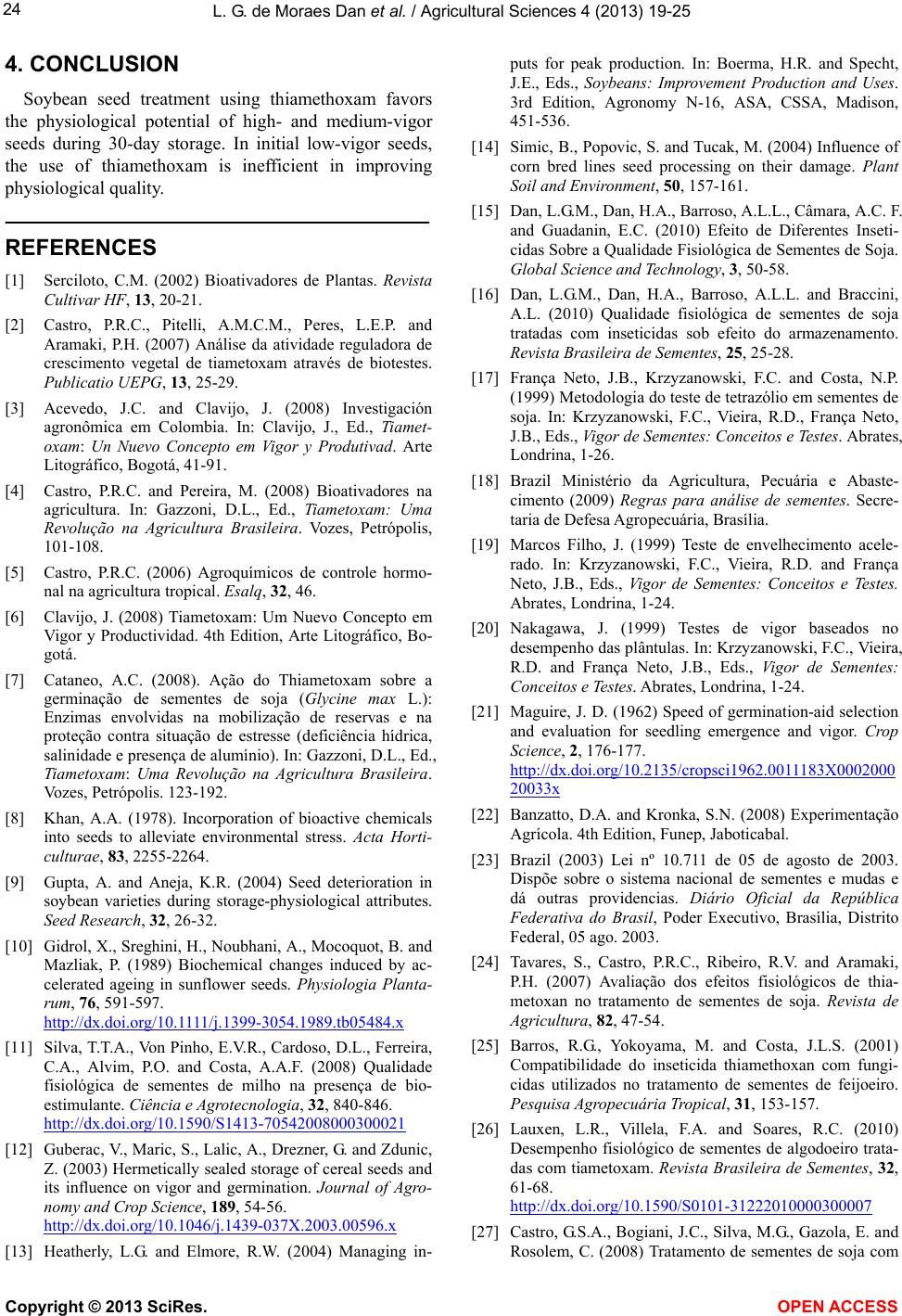
L. G. de Moraes Dan et al. / Agricultural Sciences 4 (2013) 19-25
24
4. CONCLUSION
Soybean seed treatment using thiamethoxam favors
the physiological potential of high- and medium-vigor
seeds during 30-day storage. In initial low-vigor seeds,
the use of thiamethoxam is inefficient in improving
physiological quality.
REFERENCES
[1] Serciloto, C.M. (2002) Bioativadores de Plantas. Revista
Cultivar HF, 13, 20-21.
[2] Castro, P.R.C., Pitelli, A.M.C.M., Peres, L.E.P. and
Aramaki, P.H. (2007) Análise da atividade reguladora de
crescimento vegetal de tiametoxam através de biotestes.
Publicatio UEPG, 13, 25-29.
[3] Acevedo, J.C. and Clavijo, J. (2008) Investigación
agronômica em Colombia. In: Clavijo, J., Ed., Tiamet-
oxam: Un Nuevo Concepto em Vigor y Produtivad. Arte
Litográfico, Bogotá, 41-91.
[4] Castro, P.R.C. and Pereira, M. (2008) Bioativadores na
agricultura. In: Gazzoni, D.L., Ed., Tiametoxam: Uma
Revolução na Agricultura Brasileira. Vozes, Petrópolis,
101-108.
[5] Castro, P.R.C. (2006) Agroquímicos de controle hormo-
nal na agricultura tropical. Esalq, 32, 46.
[6] Clavijo, J. (2008) Tiametoxam: Um Nuevo Concepto em
Vigor y Productividad. 4th Edition, Arte Litográfico, Bo-
gotá.
[7] Cataneo, A.C. (2008). Ação do Thiametoxam sobre a
germinação de sementes de soja (Glycine max L.):
Enzimas envolvidas na mobilização de reservas e na
proteção contra situação de estresse (deficiência hídrica,
salinidade e presença de alumínio). In: Gazzoni, D.L., Ed.,
Tiametoxam: Uma Revolução na Agricultura Brasileira.
Vozes, Petrópolis. 123-192.
[8] Khan, A.A. (1978). Incorporation of bioactive chemicals
into seeds to alleviate environmental stress. Acta Horti-
culturae, 83, 2255-2264.
[9] Gupta, A. and Aneja, K.R. (2004) Seed deterioration in
soybean varieties during storage-physiological attributes.
Seed Research, 32, 26-32.
[10] Gidrol, X., Sreghini, H., Noubhani, A., Mocoquot, B. and
Mazliak, P. (1989) Biochemical changes induced by ac-
celerated ageing in sunflower seeds. Physiologia Planta-
rum, 76, 591-597.
http://dx.doi.org/10.1111/j.1399-3054.1989.tb05484.x
[11] Silva, T.T.A., Von Pinho, E.V.R., Cardoso, D.L., Ferreira,
C.A., Alvim, P.O. and Costa, A.A.F. (2008) Qualidade
fisiológica de sementes de milho na presença de bio-
estimulante. Ciência e Agrotecnologia, 32, 840-846.
http://dx.doi.org/10.1590/S1413-70542008000300021
[12] Guberac, V., Maric, S., Lalic, A., Drezner, G. and Zdunic,
Z. (2003) Hermetically sealed storage of cereal seeds and
its influence on vigor and germination. Journal of Agro-
nomy and Crop Science, 189, 54-56.
http://dx.doi.org/10.1046/j.1439-037X.2003.00596.x
[13] Heatherly, L.G. and Elmore, R.W. (2004) Managing in-
puts for peak production. In: Boerma, H.R. and Specht,
J.E., Eds., Soybeans: Improvement Production and Uses.
3rd Edition, Agronomy N-16, ASA, CSSA, Madison,
451-536.
[14] Simic, B., Popovic, S. and Tucak, M. (2004) Influence of
corn bred lines seed processing on their damage. Plant
Soil and Environment, 50, 157-161.
[15] Dan, L.G.M., Dan, H.A., Barroso, A.L.L., Câmara, A.C. F.
and Guadanin, E.C. (2010) Efeito de Diferentes Inseti-
cidas Sobre a Qualidade Fisiológica de Sementes de Soja.
Global Science and Technology, 3, 50-58.
[16] Dan, L.G.M., Dan, H.A., Barroso, A.L.L. and Braccini,
A.L. (2010) Qualidade fisiológica de sementes de soja
tratadas com inseticidas sob efeito do armazenamento.
Revista Brasileira de Sementes, 25, 25-28.
[17] França Neto, J.B., Krzyzanowski, F.C. and Costa, N.P.
(1999) Metodologia do teste de tetrazólio em sementes de
soja. In: Krzyzanowski, F.C., Vieira, R.D., França Neto,
J.B., Eds., Vigor de Sementes: Conceitos e Testes. Abrates,
Londrina, 1-26.
[18] Brazil Ministério da Agricultura, Pecuária e Abaste-
cimento (2009) Regras para análise de sementes. Secre-
taria de Defesa Agropecuária, Brasília.
[19] Marcos Filho, J. (1999) Teste de envelhecimento acele-
rado. In: Krzyzanowski, F.C., Vieira, R.D. and França
Neto, J.B., Eds., Vigor de Sementes: Conceitos e Testes.
Abrates, Londrina, 1-24.
[20] Nakagawa, J. (1999) Testes de vigor baseados no
desempenho das plântulas. In: Krzyzanowski, F.C., Vieira,
R.D. and França Neto, J.B., Eds., Vigor de Sementes:
Conceitos e Testes. Abrates, Londrina, 1-24.
[21] Maguire, J. D. (1962) Speed of germination-aid selection
and evaluation for seedling emergence and vigor. Crop
Science, 2, 176-177.
http://dx.doi.org/10.2135/cropsci1962.0011183X0002000
20033x
[22] Banzatto, D.A. and Kronka, S.N. (2008) Experimentação
Agrícola. 4th Edition, Funep, Jaboticabal.
[23] Brazil (2003) Lei nº 10.711 de 05 de agosto de 2003.
Dispõe sobre o sistema nacional de sementes e mudas e
dá outras providencias. Diário Oficial da República
Federativa do Brasil, Poder Executivo, Brasília, Distrito
Federal, 05 ago. 2003.
[24] Tavares, S., Castro, P.R.C., Ribeiro, R.V. and Aramaki,
P.H. (2007) Avaliação dos efeitos fisiológicos de thia-
metoxan no tratamento de sementes de soja. Revista de
Agricultura, 82, 47-54.
[25] Barros, R.G., Yokoyama, M. and Costa, J.L.S. (2001)
Compatibilidade do inseticida thiamethoxan com fungi-
cidas utilizados no tratamento de sementes de feijoeiro.
Pesquisa Agropecuária T ropical, 31, 153-157.
[26] Lauxen, L.R., Villela, F.A. and Soares, R.C. (2010)
Desempenho fisiológico de sementes de algodoeiro trata-
das com tiametoxam. Revista Brasileira de Sementes, 32,
61-68.
http://dx.doi.org/10.1590/S0101-31222010000300007
[27] Castro, G.S.A., Bogiani, J.C., Silva, M.G., Gazola, E. and
Rosolem, C. (2008) Tratamento de sementes de soja com
Copyright © 2013 SciRes. OPEN A CCESS